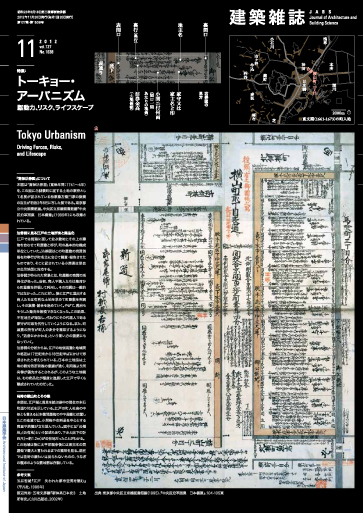本文PDFの閲覧につきましては、こちらでご確認ください。

2012-11月号 NOVEMBER
特集= トーキョー・アーバニズム
─駆動力、リスク、ライフスケープ
Tokyo Urbanism─ Driving Forces, Risks, and Lifescape
特集前言 東京は都市モデルたりえているのか
新興国経済の急成長、グローバルな都市間競争の激化、国内市場の縮小・低迷、広範な社会構造の変化といった今日の環境のもとで、すでに大きな開発フロンティアを失った東京はどこに向かうのか。ネオリベラルな都市政策は既存の都市領域内にターゲットを求め資本活動のさらなるフロンティアを生み出そうとするが、その一方では、別種の小さな変化の集積が都市のありようをじわじわとつくり変えようとしている。
東京の未来を見通そうとするとき、従来の歩みの延長上にそれがないことはたしかだ。それゆえに、東京をこれまでかたちづくってきた軌跡とその結果としての現在の東京の姿が世界史的にみても特徴的なものであったことに、多くの人があらためて気付きつつある。災害リスクという視座も、東京の都市構造と国土における位置を見直す契機となる。また、東京を目指してきた地方都市が今や独自の道を模索しはじめていることも、この巨大都市を相対化させる背景であろう。
本特集では、東京を主題に以下のことを考えた。
1. 東京をかたちづくってきた駆動力は、おそらく土地不動産を流動化し、大小資本の活動を刺激して都市の再編を推し進めるような諸制度であり、事業群であり、欲望であっただろう。高度な鉄道網等の基盤構造も含め、東京は中心を欠いた群島的風景をなしている。それは世界史的な視野でどのように規定されうるのか。そろそろ歴史的に総括されるべき時期に来ている。そして、これまでの駆動力は今どの程度の力を持ちうるのか。
2. 東京の歩みは破壊と再生の軌跡であり、災害リスクとの闘いでもあったが、東京をつくり出した駆動力とそれが描いた成長の軌跡は、巨大で特徴的なリスクを生み出してきたのだとも言える。その認識からどのような東京論が示唆されるだろうか。そして、私たちは分厚い歴史に根ざすリスクをどう扱っていけばよいのか。
3. 開発フロンティアが縮小するなかで、眼前にある膨大・多様なストックは、一方ではまだ華々しい再開発のターゲットとなり、他方では社会構造やライフスタイルの変化を支える資産として再発見されつつある。そうした動きは東京をどのように変えていくのか。それは今後の都市の駆動力を担えるのか。そして、東京はどのようなライフスケープを構想できるのか。
緊密に結び付き合うこれら三つの問いが、特集の3部構成に対応している。全体を通じて、都市というものの存立への問いが示唆されてもいることに留意したい。
巻頭は、『土地の神話』『ミカドの肖像』の著者であり、東京都副都知事である猪瀬直樹氏への特別インタビューである。氏の東京論、行政体論が縦横に展開される。
第1部「『東京』をかたちづくってきた力」では、まず6ページにわたり「東京の土地・空間史年表」を掲載した。本号表紙は18世紀江戸町人地の地籍図(沽券絵図)の解題としたが、その江戸を基盤として、東京がいかに土地と空間を再編してきたのかがこの年表で追跡されている。続いて平山洋介、藤村龍至、三輪恭之の各氏に、東京を動かしてきた力の現在形をどう見るか、それぞれの観点から論じていただいた。
第2部は「蓄積されてきた『東京』の災害リスクとそのマネジメント」と題している。加藤孝明氏にはメガシティ東京がはらむリスク、増田幸宏氏には高度に集積される都市機能の維持、瀬田史彦氏には東京一極集中のリスクについて、それぞれ論じていただいた。今回は言及できなかったが、地下街を含む駅複合体のような特異な都市基盤施設を東京は膨大に抱えている。
第3部「リスク都市『東京』で営まれるライフスケープの評価」は三つの座談会で構成した。田村誠邦、大月敏雄、根本祐二の三氏には主として建物ストックの観点から、出口敦、李政炯の両氏には東京─ソウルを比較する観点から、そしてダルコ・ラドヴィッチ、三宅理一の両氏にはより広く包括的な都市文化の観点から、それぞれ東京のありうべきライフスケープを展望していただいている。
会誌編集委員会
中島直人(慶應義塾大学)・初田香成(東京大学)・藤原健二(内閣官房地域活性化統合事務局/内閣府地域活性化推進室)
[目次]
| 000 | 連載 再建への意志:図面のなかの都市復興 明暦江戸大絵図/小林信也 |
| 002 | 連載 東日本大震災|連続ルポ1|動き出す被災地 避難地図から街づくりのプラットフォームへ ─「逃げ地図」の可能性/羽鳥達也 |
| 004 | 連載 東日本大震災|連続ルポ2|仮すまいの姿 コミュニティケア型仮設住宅─岩手県釜石市と遠野市での試み/冨安亮輔 |
特集 トーキョー・アーバニズム ─駆動力、リスク、ライフスケープ
| 006 | 特集前言 東京は都市モデルたりえているのか |
| 008 | 巻頭特別インタビュー 東京はどこから来て、どこへ向かっているのか/猪瀬直樹 |
第1部 「東京」をかたちづくってきた力
| 014 | 東京の土地・空間史年表/石榑督和 + 市川尭之 + 髙橋元貴 + 高道昌志 + 似内遼一 + 福村任生 + 宮脇哲司 |
| 020 | 東京ライフスケープ/平山洋介 |
| 024 | 巨大開発の時代(1968-2011)の終焉と現代日本の新たな生命線/藤村龍至 |
| 028 | 世界の都市総合ランキング(GPCI)に見る東京の国際競争力と災害リスク/三輪恭之 |
第2部 蓄積されてきた「東京」の災害リスクとそのマネジメント
| 030 | メガシティ東京の災害リスクと防災都市づくり/加藤孝明 |
| 034 | 拠点建物の適切な機能維持の重要性とその対策 ─リジリエントな都市・東京の実現に向けて/増田幸宏 |
| 036 | 災害リスクと東京一極集中の国土形成/瀬田史彦 |
第3部 リスク都市「東京」で営まれるライフスケープの評価
| 038 | 座談会 東京のストックをどう評価し、どう暮らすのか? 大月敏雄 × 田村誠邦 × 根本祐二 |
| 044 | 対談 「東京」はアジアにおいていかなるプレゼンスを持っているか? 出口敦 × 李政炯 |
| 047 | 対談 東京のライフスケープは世界に対して、一体何を発信できるのか? 三宅理一 × ダルコ・ラドヴィッチ |
| 052 | 編集後記 中島直人 |
| 052 | 次号予告 2012年12月号|特集:東日本大震災 復興のアポリア ─居住地再建の諸問題 |
| 053 | 連載 建築の争点 アルゴリズムと構造デザイン/斎藤公男 |
| 054 | 連載 ケンチク脳の育て方 手に触れる。/今本啓一 |
| 055 | 連載 ケンチク脳の活かし方 多元的デジタルアーカイブは時空を越えて記憶をつなぐ/渡邉英徳 |
| 056 | 連載 地域いろいろ・多様な日本 川の魅力・水辺の魅力が溢れるまち・大阪/松本拓 |
Preface to the Special Issue: Is Tokyo Sufficient as a City Model?
Now that Tokyo has largely lost its developmental frontiers, where is it headed in today's environment of rapid economic growth in emerging countries, heightened global competition between cities, shrinking and sluggish domestic markets, and widely changing social structures? Although neoliberal urban policy tries to provide more frontiers for capital activities seeking targets in existing city areas, other kinds of minor-change congeries try to gradually remodel city conditions.
When we attempt to foresee Tokyo's future, it certainly isn't in a continuation of its hitherto trace. Therefore, many people are noticing afresh that the track that formed Tokyo until now and the resulting present shape of Tokyo were characteristic in view of world history. The standpoint of so-called disaster risks also could be an opportunity to review Tokyo's urban structure and position in the country. And the fact that provincial cities that once aimed at being like Tokyo have now started seeking their own way would be a background that relativizes the enormous city.
In this feature, we think as below on the subject of Tokyo.
1. Probably the driving forces that have been shaping Tokyo would have been the systems, projects, and desire that promoted city reorganization by stimulating all sizes of capital activities, making land and real estate fluid. Tokyo forms an acentric archipelagic scene including infrastructures of sophisticated rail networks and so on. How could all this have been ordained in view of world history? The time to round up historically has almost come. And how much power can these prior driving forces have now?
2. Although Tokyo's path was a track of destruction and reclamation, and a struggle with disaster risks, we could say that the driving forces and the growth track they drew bore enormous and characteristic risks. From this perception, what theory of Tokyo is indicated? And how are we going to deal with risks that arose from that thick history?
3. While developmental frontiers are shrinking, the huge and various stocks before us on the one hand become targets for glorious redevelopments and on the other hand are beginning to be rediscovered as fortunes that support social structures and changes in lifestyle. How are such movements changing Tokyo? Can they shoulder the city's driving forces hereafter? And what lifescape can Tokyo design?
These three questions interconnect with each other and correspond to the three feature parts. Throughout, we would like to be attentive enough to inspire questions about the existence of cities.
The journal opens with a special interview with Naoki Inose, the author of The Myth of Land and A Portrait of Mikado and also a vice governor of Tokyo. His views of Tokyo and governmental theory evolve in myriad directions.
Part 1, "The Power That's Been Shaping Tokyo," opens with a six-page "Chronology of Land and Space." This issue's cover shows a bibliography of cadastral maps of common people's areas in eighteenth-century Edo, and the chronology traces how Tokyo has reorganized land and space based on Edo. After that, Yosuke Hirayama, Ryuji Fujimura, and Yasuyuki Miwa present their individual views on the current powers that have moved Tokyo.
Part 2 is titled "Tokyo's Accumulating Disaster Risks and Their Management." Takaaki Kato addresses the risks contained in mega-city Tokyo; Yukihiro Masuda, the continuity of highly accumulated city functions; and Fumihiko Seta, the mono-centralized risks in Tokyo. And although not referred to this time, Tokyo prodigiously has unique citybase- facilities such as station complexes that include underground shopping centers.
Part 3, "An Evaluation of the Lifescape Operating in Tokyo, 'Risk City'," is composed of three conversations, each with a distinct outlook on what Tokyo's lifescape should be: Masakuni Tamura, Toshio Otsuki, and Yuji Nemoto mainly focus on building stock; Atsushi Deguchi and Jung Hyung Lee, on a comparison between Tokyo and Seoul; and Darko Radović and Riichi Miyake, on a widely comprehensive city culture.
Editorial Board
This issue has been edited by Naoto Nakajima (Keio University), Kosei Hatsuda (The University of Tokyo), and Kenji Fujiwara (The Cabinet Office).
[Contents]
| 000 | [Series] The Resolve to Rebuilding: City Reconstruction in Blueprint Meireki Edo Oezu, Map of Edo, ca. 1657 / Shinya Kobayashi |
| 002 | [Series] Great East Japan Earthquake Serial Report 1 Devastated Areas Have Just Started to Stir From Evacuation Maps to Platforms for Town Planning ─The Possibility of "Nige-Chizu" / Tatsuya Hatori |
| 004 | [Series] Great East Japan Earthquake Serial Report 2 Life in Temporary Housing Community-Care-Type Temporary Housings ─Attempts in Iwate's Kamaishi and Tono / Ryosuke Tomiyasu |
Special Feature
Tokyo Urbanism─Driving Forces, Risks, and Lifescape
| 006 | [Preface to the Special Issue] Is Tokyo Sufficient as a City Model? |
| 008 | [Opening Interview] Where Tokyo Comes From and Is Headed / Naoki Inose |
Part1 The Power That's Been Shaping Tokyo
| 014 | Chronology of Land and Space in Tokyo / Masakazu Ishigure + Takayuki Ichikawa + Genki Takahashi + Masashi Takamichi + Ryoichi Nitanai + Mizuki Fukumura + Satoshi Miyawaki |
| 020 | Transformations in the life-scapes of Tokyo / Yosuke Hirayama |
| 024 | The End of Big Project Era (1968-2011) and The New Lifeline of Contemporary Japan / Ryuji Fujimura |
| 028 | Global Competitiveness and Disaster Risk of Tokyo in the Global Power City Index (GPCI) / Yasuyuki Miwa |
Part2 Tokyo's Accumulating Disaster Risks and Their Management
| 030 | Tokyo's Disaster Risk and Urban Planning for Disaster Resistant City For the Future / Takaaki Kato |
| 034 | Maintaining Building Function Continuity in the Event of a Disaster to Develop Resilient City, Tokyo / Yukihiro Masuda |
| 036 | Disaster Risks and Mono-Centralized Spatial Structure to Tokyo / Fumihiko Seta |
Part3 An Evaluation of the Lifescape Operating in Tokyo, "Risk City"
| 038 | [Discussion] How to Evaluate Tokyo' s Infrastructural Stock and How to Live? Toshio Otsuki × Masakuni Tamura × Yuji Nemoto |
| 044 | [Dialogue] Does Tokyo Have Any Presence in Asia? Atsushi Deguchi × Jung Hyung Lee |
| 047 | [Dialogue] What can the world learn from the lifescape and urbanism in Tokyo? Riichi Miyake × Darko Radović |
| 052 | [Editor's Postscripts] Naoto Nakajima |
| 052 | [Previews of Coming Issues] 2012, December|Aporia in Recovery from the Great East Japan Earthquake ─ Issues in Domicile Rehabilitation |
| 053 | [Series] Issues in Architecture Algorithms and Structural Design / Masao Saito |
| 054 | [Series] Cultivating Versatile Architects Touch and feel / Kei-ichi Imamoto |
| 055 | [Series] Architects Branch Out Pluralistic Digital Archives Link Memories over Space-Time / Hidenori Watanave |
| 056 | [Series] Local Identities: Diverse Japan Osaka, a City Brimming with Riverside and Waterside Attractions / Taku Matsumoto |




 『幸せな名建築たち 住む人・支える人に学ぶ42のつきあい方』
『幸せな名建築たち 住む人・支える人に学ぶ42のつきあい方』





